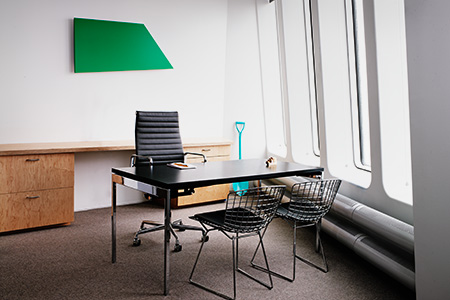A Look Inside Adam Weinberg’s Office
by Natasha Wolff | March 3, 2016 1:50 pm
The one thing you’re always aware of in this building is that you’re on an island,” says Adam Weinberg, director of the Whitney Museum of American Art[1], sitting on a wire-mesh Bertoia chair in his eighth-floor office. “You always have a sense of place.”
The museum reopened to the public—and to much fanfare—in the Meatpacking District[2] last spring, after 49 years in its Marcel Breuer-designed modernist home on the Upper East Side. Weinberg, who has led the Whitney since 2003, worked closely with the building’s architect, Renzo Piano, throughout the eight-year, $422 million project.
Long before cutting any ribbons downtown, Weinberg wanted everyone inside the new 220,000-square-foot space—visitors, curators, art handlers, guards—to have views of the outside. “In our building uptown, you could be in Lawrence, Kansas, or you could be in Seoul, Korea, and not know where you were,” says Weinberg.
One of the most striking aspects of his office, aside from the monastic tidiness and vertiginous views of the river, is the scarcity of art. Weinberg, who could select any piece in the collection for his workspace, chose only two, largely due to the sunlight that pours in through four Starship Enterprise-esque windows.
Behind his minimalist desk, designed by Piano after learning that Weinberg prefers to work at a simple table, hangs a painted aluminum wall sculpture by Ellsworth Kelly. “He’s an artist who has a deep connection to our history and to New York,” says Weinberg. Kelly’s “Green Panel (Ground Zero)” replicates the shape of a New York Times aerial photograph of the World Trade Center site after 9/11, and it hangs on the southern wall, in the direction of the fallen towers. The other piece of artwork, a black wall-mounted sculpture, “Constellation,” is by Alexander Calder. Weinberg admires how it’s “both biomorphic and galactic,” pointing at the arachnid shadows cast by its wiry arms.

Adam Weinberg’s desk
Weinberg likes to keep his desk unfettered. Aside from two stones (he collects striped rocks) and a small model of the new museum (a gift from Piano), only a pen, pencil and some paper claim real estate. He has no need for a computer, preferring instead to use his iPhone and iPad. “I’ve decided that I’m too mobile and not the best typist anyway,” he says.
According to Elisabetta Trezzani, a partner in Piano’s firm, extensive planning went into the configuration of his office. “One of the main ideas was to give him a view of the west, which is in some way the view of the future,” she says.
Speaking with Weinberg—who is busy planning upcoming exhibitions[3], including one of the modernist painter Stuart Davis that opens this June—it is clear how much he values the museum’s relationship with its surroundings. Weather permitting, he begins each morning on one of the building’s terraces to “get a breath of fresh air, look around,” he says, and will often use exterior stairwells to travel between floors.
“The great American museum, and you’re looking out across the big open spaces of the west,” he says, nodding in the direction of the sun as it dips behind the New Jersey Palisades. “I’m here all hours of the day and night, which is what I love about this office—the changing light.”
- Whitney Museum of American Art: http://dujour.com/cities/whitney-museum-of-american-art-opening-party-pictures/
- Meatpacking District: http://dujour.com/cities/meatpacking-district-shopping-restaurants-art-bars-yoga/
- upcoming exhibitions: http://dujour.com/culture/frank-stella-retrospective-whitney-museum-of-american-art/
Source URL: https://dujour.com/design/adam-weinberg-whitney-director-office-photos/